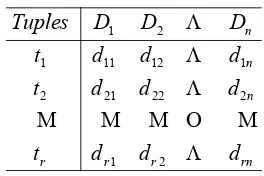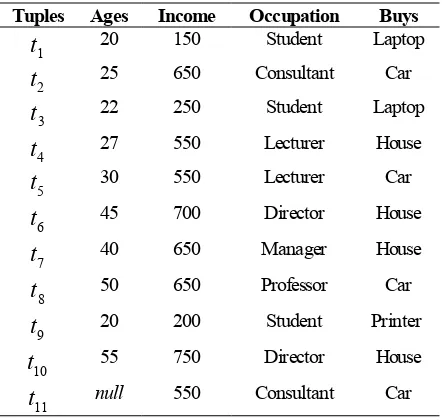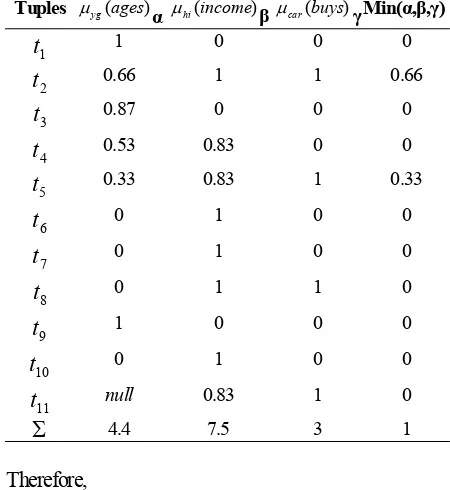Jurusan Teknik Informatika, Fakultas Teknologi Industri – Universitas Kristen Petra Rolly Intan
Department of Informatics Engineering, Petra Christian University, Surabaya Email: [email protected]
ABSTRACT: Association rules that involve two or more dimensions or predicates can be referred as
multidimensional association rules. Rather than searching for frequent itemsets (as is done in mining single-dimensional association rules), in multisingle-dimensional association rules, we search for frequent predicate sets. In general, there are two types of multidimensional association rules, namely interdimension association rules and hybrid-dimension association rules. Interdimension association rules are multidimensional association rules with no repeated predicates. This paper introduces a method for generating interdimension association rules. A more meaningful association rules can be provided by generalizing crisp value of attributes to be fuzzy value. To generate the multidimensional association rules implying fuzzy value, this paper introduces an alternative method for mining the rules by searching for the predicate sets.
Keywords: Multidimensional Association rules, Inter- dimension Association Rules, Data Mining, Fuzzy Sets.
INTRODUCTION
Association rule mining finds interesting association or correlation relationship among a large data set of items [1,8,11]. The discovery of interesting association rules can help in decision making process.
Association rule mining that implies a single predicate is referred as a single dimensional or
intradimension association rule since it contains a
single distinct predicate with multiple occurrences (the predicate occurs more than once within the rule). The terminology of single dimensional or intradimension association rule is used in multidimensional database by assuming each distinct predicate in the rule as a dimension. For instance, in market basket analysis, customers buying habit is analyzed for finding association between different items customers put together in their shopping cart. In market basket analysis, it might be discovered a Boolean association rule “laptop
⇒
b/w printer” which can also be written as a single dimensional association rule as follows [1]:Rule-1
buys (X, “laptop”)
⇒
buys (X, “b/w printer”),where buys is a given predicate and X is a variable representing customers who purchased items (e.g.
laptop and b/w printer). In general, laptop and b/w printer are two different data that are taken from a certain database attribute, called items. In general,
Apriori [1,8] is used an influential algorithm for
mining frequent itemsets for generating Boolean (single dimensional) association rules. To provide a more human-based concept, in [6,11] we proposed an alternative algorithm for generating the (single dimensional) association rule by utilizing fuzzy sets in the market basket analysis.
Additional relational information regarding the customers who purchased the items, such as customer age, occupation, credit rating, income and address, may also have a correlation to the purchased items. Considering each database attribute as a predicate, it can therefore be interesting to mine association rules containing multiple predicate, such as:
Rule-2
), laptop" " , ( ) student" " , (
) "20" ,
(X occupation X buys X
age ∧ ⇒
where there are three predicates, namely age,
occupation and buys. Association rules that involve two or more dimensions or predicates can be referred to as multidimensional association rules.
To provide a more meaningful association rule, it is necessary to utilize fuzzy sets over a given database attribute as discussed in [13]. Formally, given a crisp domain attribute D, any arbitrary fuzzy set (say, fuzzy set A) is defined by a membership function of the form [2,7]:
:
[0,1].
A D
→
(1)A fuzzy set may be represented by a meaningful fuzzy label. For example, “young” is a fuzzy set over
age that is defined on the interval [0, 100], and “high_inc” is a fuzzy set over income on the interval [100, 1000] as arbitrarily given by:
≥< < −
≤ =
≥< < −
≤ =
600 when
1
600 300
when 300 / ) 300 (
300 when
0
) ( _
35 when 0
35 20
when 15
/ ) 35 (
20 when 1
) (
x x x
x x
inc high
x x x
x x
Using the previous definition of fuzzy sets on age
and income, an example of multidimensional
association rule relation among the predicates age,
income and buys may then be represented by:
Rule-3
), car" " , ( ) high_inc" "
, ( ) young" " ,
(X income X buys X
age ∧ ⇒
To generate multidimensional association rules
implying fuzzy value as given by the above example, this paper introduces an alternative method. The method considered as an extended concept of our previous algorithm proposed in [11]. Two important formulas are introduced to calculate support and
confidence factor for every association rule.
The structure of the paper is the following. In Section II, basic definition and formulation of association rules, support and confidence rule are briefly recalled. Section III as a main contribution of this paper is devoted to propose a concept for generating multidimensional associationrules mining. Section IV demonstrated the concept in an illustrative example. Finally a conclusion is given in Section V.
ASSOCIATION RULES, SUPPORT AND CON-FIDENCE
Association rules are kind of patterns representing correlation of attribute-value in a given set of data provided by a process of data mining system. Generally, association rule is a conditional statement (such kind of if-then rule). More formally [2], association rules are the form A⇒B, that is,
n
m
B
B
A
A
1∧
Λ
∧
⇒
1∧
Λ
∧
, whereA
i(for i∈
{1,…,m}) and Bj(for j
∈
{1,…,n}) areattribute-value pairs. The association rule A⇒Bis inter-preted as “ database tuples that satisfy the conditions in A are also likely to satisfy the conditions in B.” Performance of an association rule is determined by two factors, namely confidence and support factors. Confidence is a measure of certainty to assess the validity of the rule. Given a set of relevant data tuples (or transactions in a transaction database) the confidence of “A⇒B” is defined by:
# ( and )
confidence( ) ,
# ( )
tuples A B
A B
tuples A
⇒ = (2)
where #tuples(A and B) means the number of tuples containing A and B.
For example, a confidence 80% for the Association Rule (Rule-1) means that 80% of all customers who purchased a laptop also bought b/w printer. The support of an association rule refers to the
percentage of relevant data tuples (or transactions) for which the pattern of the rule is true. For the association rule “A⇒B” where A and B are the sets of items, support of the rule can be defined by
support( ) support( ) # ( and ) ,
# ( _ )
A B A B
tuples A B
tuples all data
⇒ = ∪
= (3)
where #tuples(all_data) is the number of all tuples in the relevant data tuples (or transactions).
For example, a support 30% for the Association Rule (Rule-1) means that 30% of all customers in the all transactions purchased both laptop and b/w printer. From (3), it can be followed support (A⇒B)=
support (
B
⇒
A
).
Also, (2) can be calculated bysupport ( )
confidence( ) ,
support ( )
A B
A B
A
∪
⇒ = (4)
A data mining system has the potential to generate a huge number of rules in which not all of the rules are interesting. Here, there are several objective measures of rule interestingness. Two of them are measure of rule support and measure of rule confidence. In general, each interestingness measure is associated with a threshold, which may be controlled by the user. For example, rules that do not satisfy a confidence threshold (minimum confidence) of, say 50% can be considered uninteresting. Rules below the threshold (minimum support as well as minimum
confidence) likely reflect noise, exceptions, or
minority cases and are probably of less value.
MULTIDIMENSIONAL ASSOCIATION RULES
As explained in the previous section association rules that involve two or more dimensions or predicates can be referred to as multidimensional
association rules. Multidimensional rules with no
repeated predicates are called interdimension association rules (e.g. Rule-2)[1]. On the other hand,
multidimensional association rules with repeated
predicates, which contain multiple occurrences of some predicates, are called hybrid-dimension association rules. The rules may be also considered as combination (hybridization) between intradimension
association rules and interdimension association
rules. An example of such a rule is the following,
where the predicate buys is repeated:
Rule-4:
). printer" b/w " , ( ) laptop" " , ( ) "20" ,
(X buys X buys X
age ∧ ⇒
predicates or interdimension association rules.
Hybrid-dimension association rules as an extended
concept of multidimensional association rules will be discussed later in our next paper.
The interdimension association rules may be generated from a relational database or data ware-house with multiple attributes by which each attribute is associated with a predicate. A relational database [12] R consists of a set of tuples, where ti represents the i-th tuple and if there are n domain attributes D, then
t
i=
(
d
i1,
d
i2,
Λ
,
d
in).
Here, dij is an atomic value of tuple ti with the restriction to the domain Dj,where dij∈Dj. Formally, a relational database R is defined as a subset of the set of cross product
.
2
1 D Dn
D × ×Λ × Tuple t (with respect to R) is an element of R. In general, R can be shown in Table 1.
Table 1. A Relational Database
rn
To generate the multidimensional association rules, we introduce an alternative method for mining the rules by searching for the predicate sets. Conceptually, a multidimensional association rule,
B
A⇒ consists of A and B as two datasets, called premise and conclusion, respectively.
Formally, A is a dataset consisting of several distinct data, where each data value in A is taken from a distinct domain attribute in D as given by:
}
Similarly,
}
Considering A⇒B is an interdimension asso-ciation rule, it can be proved that|DA|=|A|,
in the process of mining association rules are records in which data values of a certain set of domain attributes, DA, are not null data. Hence, (5) can be also
defined by:
|
values of domain attributes in DA are not null data.
Formally, QD(DA) is defined as follows.
If support(A) is calculated by (5) and denominator of (9) is changed to r, clearly, (10) can be proved having relation as given by (4).
A and B in the previous discussion are datasets in which each element of A and B is an atomic crisp value. To provide a generalized multidimensional association rules, instead of an atomic crisp value, we may consider each element of the datasets to be a dataset of a certain domain attribute. Hence, A and B
are sets of set of data values. For example, the rule may be represented by
where A={{20…29}, {400…900}} and B={{car, house}}. Simply, let A be a generalized dataset. Formally, A is given by
Corresponding to (6), support of A is then defined by:
|
To provide a more generalized multidimensional association rules, we may consider A and B as sets of fuzzy labels. Here, we can use meaningful fuzzy label to provide a more meaningful association rules. Simply, A and B are called fuzzy datasets. Rule-3 is an example of such rules, where A={young, high_inc} and B={car}. A fuzzy dataset is a set of fuzzy data consisting of several distinct fuzzy labels, where each fuzzy label is represented by a fuzzy set on a certain domain attribute. Let A be a fuzzy dataset. Formally, A
is given by
Similarly, If denominators of (14) and (15) are changed to r (the number of tuples), (16) can be proved also having relation as given by (4). Here, we may consider and prove that (15) and (16) are
generalization of (12) and (13), respectively. On the other hand, (12) and (13) are generalization of (9) and (10).
ILLUSTRATIVE EXAMPLE
An illustrative example is given to understand well the concept of the proposed method and how to calculate support and confidence of the multidimen-sional association rule mining is performed. The process is started from a given transactional database as shown in Table 2.
Table 2. Transactional Database
Tuples Ages Income Occupation Buys
1
t
20 150 Student Laptop2
t
25 650 Consultant Car3
Based on Table 2, support and confidence of Rule-2 are calculated using (9) and (10), respectively.
Related to the conceptual form of the ruleA⇒B, it can be followed that A={20, student} and B={laptop}.
1
1 10
|{ } |
support (Rule-2) 0.1 | { ,..., } | value in Ages. Confidence of Rule-2 is given by
.
Support and confidence of Rule-5 are calculated using (12) and (13) as follows.
2 4 1 10
| { , } |
support (Rule-5) 0.2,
are two fuzzy labels represented by two fuzzy sets as given in Section I. Support of Rule-3 can be calculated by (15) as shown in the following table.
Table 3. Calculation of Fuzzy Values
Tuples µyg(ages)α µhi(income) µcar(buys) Min(α, , )
1
t
1 0 0 02
t
0.66 1 1 0.663
t
0.87 0 0 04
t
0.53 0.83 0 05
t
0.33 0.83 1 0.336
t
0 1 0 07
t
0 1 0 08
t
0 1 1 09
t
1 0 0 010
t
0 1 0 011
t
null 0.83 1 0Σ
4.4 7.5 3 1Therefore,
. 1 . 0 | } ,..., { |
33 . 0 66 . 0 ) 3 -le support(Ru
10 1
= + =
t t
On the other hand, confidence of Rule-3 is given by:
. 65 . 0 33 . 0 53 . 0 66 . 0
33 . 0 66 . 0 ) 3 -(Rule
confidence =
+
+ +
=
Other interesting rules can be generated from Table 2 as follows.
Rule-6
) director" , consultant "
, ( )
high_inc" " ,
(X occupation X income ⇒
(support = 0.35, confidence = 0.51). On the other hand,
Rule-7
) high_inc" "
, ( )
director" , consultant "
,
(X income X
occupation ⇒
(support = 0.35, confidence = 0.96).
It can be concluded that the rule “if someone is a director or consultant, he will receive high income”, is more sure than the rule “if someone received high income, he must be a director or consultant”. The conclusion is reasonable, since from Table 2, clearly it is not only directors and consultants who received high income, but also manager and professor.
The proposed concept and method had been applied in our research to analyze medical track record patients in order to know distribution of a certain
disease [10]. In the application, the data of medical track record patients consist of Date,Allergy, Pre-diagnosis, Post-diagnosis, Disease,Address, Occupati-on,Ages,Sex,Religion,Blood Type,etc. Let, Dis a fuzzy label on diseases, Alis a fuzzy set on allergy, and Adis a fuzzy set on address that can be meant an area or location of residence. Result of fuzzy association rule can be given by the following pattern:
) " " , ( )
" " , ( and ) " " ,
(X Ad allergy X Al desease X D
address ⇒
(support= α, confidence= β).
CONCLUSION
The paper discussed a method of generating multidimensional association rules. In general, multi-dimensional association rules consist of two types of rules, namely interdimension association rules and
hybrid-dimension association rules. In this paper, we restricted our proposed method to generate inter-dimension association rules. Three pairs of equations were introduced to calculate support and confidence of three different kinds of generalized rules.
Advantage of the proposed method compared to the conventional one is that it can provide a more meaningful association rules by utilizing meaningful fuzzy labels. The problem of using fuzzy labels to provide the rules is generally how to assign appropriate membership degree for every fuzzy set.
In our next paper, we will discuss and propose a method to generate hybrid-dimension association rules by assuming that hybrid-dimension association rules is a hybridization between intradimension and interdimension association rules.
REFERENCES
1. Han J., Kamber, M., Data Mining: Concepts and Techniques, The Morgan Kaufmann Series, 2001.
2. Klir, G. J., Yuan, B., Fuzzy Sets and Fuzzy Logic:
Theory and Applications, New Jersey: Prentice
Hall, 1995.
3. Intan, R., Mukaidono, M., “Toward a Fuzzy Thesaurus Based on Similarity in Fuzzy Covering”, Australian Journal of Intelligent
Information Processing, Vol.8 No.3, 2004. pp.
132-139.
4. Intan, R., Mukaidono M., “Generating Fuzzy Thesaurus by Degree of Similarity in Fuzzy Covering”, Proceedings of ISMIS 2003, LNAI 2871, Springer-Verlag, 2003. pp. 427-432.
5. Intan, R., Mukaidono, M., “A Proposal of Fuzzy Thesaurus Generating by Fuzzy Covering”,
Proceedings of NAFIPS 2003, IEEE Press, 2003.
6. Gunawan, O. P., Perancangan dan Pembuatan Aplikasi Data Mining dengan Konsep Fuzzy c-Covering untuk Membantu Analisis Market
Basket pada Swalayan X, (in Indonesian) Final
Project, 2004.
7. Zadeh, L. A., “Fuzzy Sets and systems,”
Intern-ational Journal of General Systems, Vol. 17,
1990. pp. 129-138.
8. Agrawal, R., Imielimski, T., Swami, A.N., “Mining Association Rules between Sets of Items in Large Database”, Proccedings of ACM SIGMOD International Conference Management of Data, ACM Press, 1993. pp. 207-216.
9. Agrawal, R., Srikant, R., “Fast Algorithms for Mining Association Rules in Large Databases”,
Proccedings of 20th International Conference
Very Large Databases, Morgan Kaufman, 1994.
pp. 487-499.
10. Pesiwarissa, H. V., Perancangan dan Pembuatan Aplikasi Data Mining dalam Menganalisa Track Records Penyakit Pasien di DR.Haulussy Ambon
Menggunakan Fuzzy Association Rule Mining,
(in Indonesian) Final Project, 2005.
11. Intan, R., “An Algorithm for Generating Single Dimensional Fuzzy Association Rule Mining”,
Jurnal Informatika, Vol. 7, No. 1, Mei 2006.
12. Codd, E.F., “A Relational Model of Data for Large Shared Data Bank”, Communication of the ACM, 13(6), 1970. pp. 377-387.
13. Intan, R., Mukaidono, M., ‘Fuzzy Conditional Probability Relations and its Applications in Fuzzy Information System’, Knowledge and
Information systems, an International Journal,


